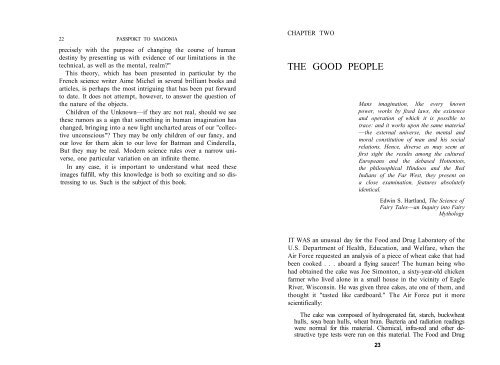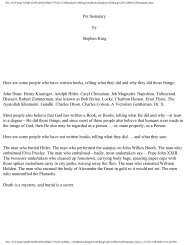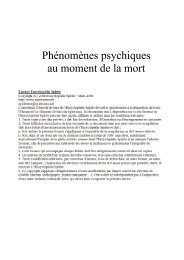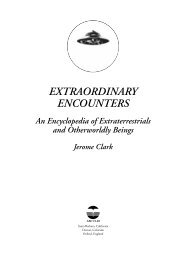You also want an ePaper? Increase the reach of your titles
YUMPU automatically turns print PDFs into web optimized ePapers that Google loves.
22 PASSPOKT TO MAGONIA<br />
precisely with the purpose of changing the course of human<br />
destiny by presenting us with evidence of our limitations in the<br />
technical, as well as the mental, realm?"<br />
This theory, which has been presented in particular by the<br />
French science writer Aime Michel in several brilliant books and<br />
articles, is perhaps the most intriguing that has been put forward<br />
to date. It does not attempt, however, to answer the question of<br />
the nature of the objects.<br />
Children of the Unknown—if they arc not real, should we see<br />
these rumors as a sign that something in human imagination has<br />
changed, bringing into a new light uncharted areas of our "collective<br />
unconscious"? They may be only children of our fancy, and<br />
our love for them akin to our love for Batman and Cinderella,<br />
But they may be real. Modern science rules over a narrow universe,<br />
one particular variation on an infinite theme.<br />
In any case, it is important to understand what need these<br />
images fulfill, why this knowledge is both so exciting and so distressing<br />
to us. Such is the subject of this book.<br />
CHAPTER TWO<br />
THE GOOD PEOPLE<br />
Mans imagination, like every known<br />
power, works by fixed laws, the existence<br />
and operation of which it is possible to<br />
trace: and it works upon the same material<br />
—the external universe, the mental and<br />
moral constitution of man and his social<br />
relations. Hence, diverse as may seem at<br />
first sight the results among the cultured<br />
Europeans and the debased Hottentots,<br />
the philosophical Hindoos and the Red<br />
Indians of the Far West, they present on<br />
a close examination, features absolutely<br />
identical.<br />
Edwin S. Hartland, The Science of<br />
Fairy Tales—an Inquiry into Fairy<br />
Mythology<br />
IT WAS an <strong>unusual</strong> day for the Food and Drug Laboratory of the<br />
U.S. Department of Health, Education, and Welfare, when the<br />
Air Force requested an analysis of a piece of wheat cake that had<br />
been cooked . . . aboard a flying saucer! The human being who<br />
had obtained the cake was Joe Simonton, a sixty-year-old chicken<br />
farmer who lived alone in a small house in the vicinity of Eagle<br />
River, Wisconsin. He was given three cakes, ate one of them, and<br />
thought it "tasted like cardboard." The Air Force put it more<br />
scientifically:<br />
The cake was composed of hydrogenated fat, starch, buckwheat<br />
hulls, soya bean hulls, wheat bran. Bacteria and radiation readings<br />
were normal for this material. Chemical, infra-red and other destructive<br />
type tests were run on this material. The Food and Drug<br />
23





